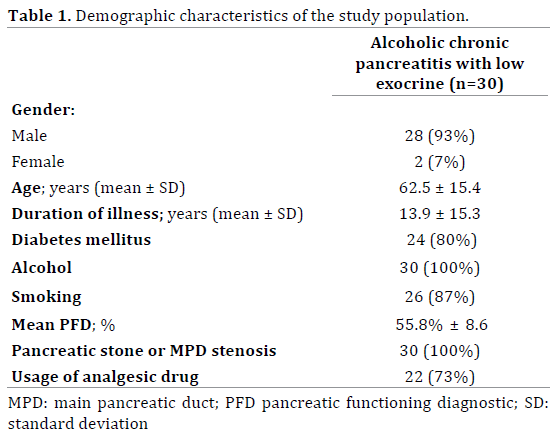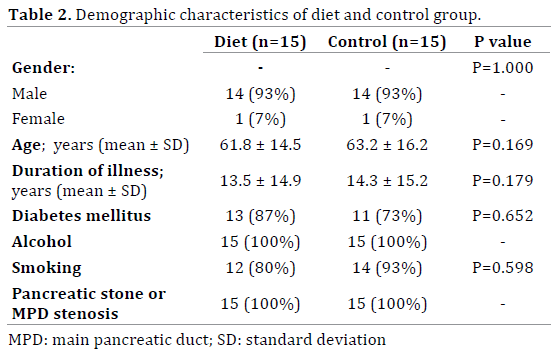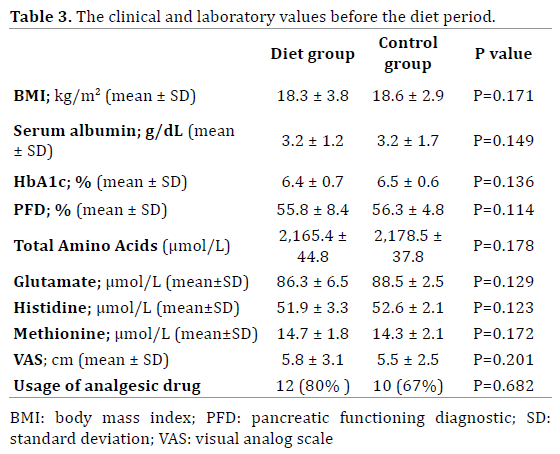- (2015) Volume 16, Issue 1
Yoshiaki Kawaguchi, Jung-Chun Lin, Yohei Kawashima, Atsuko Maruno, Hiroyuki Ito, Masami Ogawa, Tetsuya Mine
Tokai University School of Medicine, 143 Shimokasuya, Isehara, 259-1193, Japan
Received October 6th, 2014 – Accepted November 25th, 2014
Objective Our aim was to investigate the relationship between imbalances of plasma amino acids and pain in chronic pancreatitis (CP). Methods Thirty patients with alcoholic CP in an exocrine-insufficient state were examined. We divided them between diet and control group. Diet group ingested 80g/300 kcal of the elemental diet "Elental®". This diet of 300 kcal/day was administered for two months. Selected clinical and laboratory values were compared between both groups before and after diet. Pain was observed and compared using a visual analog scale (VAS). Results There was no significant difference in the BMI between both groups before and after diet. The serum albumin level in diet group after diet was significantly higher than in control group (P=0.036). There was no significant difference in HbA1c between both groups before and after diet. The total amino acid concentration was significantly higher in diet group after diet than in control group (P=0.033). The concentrations of serum histidine and methionine in diet group after diet were significantly higher than in control group (histidine, P=0.022; methionine, P=0.026). The concentration of serum glutamate in diet group after diet was significantly lower than in control group (P=0.027). The balance of amino acids in diet group was normalized after the Elental® was ingested. The VAS score was significantly lower in diet group after diet than in control group (P=0.018). Conclusion These amino acid levels and pancreatic pain were improved by the elemental diet. The pancreatic pain may be related to these amino acid imbalances.
Ethanol; Amino Acids; Food, Formulated; Pain; Pancreatitis, Chronic
CP: Chronic Pancreatitis BMI Body mass index HPLC High performance liquid chromatography ESI-MS Electrospray mass spectrometry VAS Visual analog scale PFD Pancreatic functioning diagnostic SAM S-adenosyl methionine
We reported that patients with CP, especially those with exocrine insufficiency, exhibit alterations in the levels of several amino acids, such as histidine, methionine and glutamate [1]. These amino acid changes seem to correlate with exocrine insufficiency, and the imbalances of amino acids were corrected by the elemental diet. Supplementation of these amino acids in patients with exocrine insufficiency may minimize the excess morbidity and mortality associated with protein malnutrition [1].
These CP patients experienced repeated abdominal pain, a symptom that is known to be induced by alcohol consumption, a fatty diet or overeating [2-4]. Some patients had pancreatic stones or pancreatic duct stenosis. CP patients with repeated pain should avoid alcohol consumption, maintain a low-fat diet and use non-narcotic analgesics for pain management [5]. We performed ESWL, pancreatic stenting or surgery in cases of pancreatic stones or pancreatic duct stenosis. Ito et al. reported two cases of CP with repeated pain in which the oral administration of a low-fat elemental diet offered effective pain relief [6-8].
Treatment of protein malnutrition using proteasecontaining drugs has led to significant improvements in steatorrhea, overall nutritional status and pain in CP patients [9]. It has also been reported that protein malnutrition is strongly associated with decreased serum concentrations of amino acids [10]. Regarding the mechanism, these authors speculated that the lowered amino acid levels in CP patients were probably due to intestinal malabsorption and systemic inflammation [11]. Few papers discuss the relationship between pancreatic pain and amino acid levels.
Our aim was to investigate the relationship between imbalances of plasma amino acid levels in CP patients and pancreatic pain, and clarify why elemental diet improves pain of chronic pancreatitis.
Of the patients in whom CP and exocrine insufficiency were diagnosed between 2006 and 2013 in our Department of Gastroenterology, Tokai University School of Medicine, on the basis of the following criteria, we selected a total of 30 (28 male, 2 female) who were between 33 and 79 years old (mean age, 62.5 ± 15.4 years) (Table 1), and had a history of alcoholic CP. We divided them between diet and control group by the existence of the diet therapy. Diet group included 15 (14 male, 1 female) who were between 35 and 76 years old (mean age, 61.8 ± 14.5 years), control included 15 (14 male, 1 female) who were between 33 and 79 years old (mean age, 63.4 ± 16.2 years) (Table 2). The diagnosis of CP was based on clinical symptoms and typical findings, such as pancreatic calcification and/or parenchymal or ductal changes seen in imaging techniques (ultrasonography, computed tomography, magnetic resonance imaging, endoscopic ultrasonography, endoscopic retrograde pancreatography) [12]. Patients with any degree of liver cirrhosis or pancreatic cancer, those with severe chronic pancreatitis, those who had undergone pancreatic surgery, those with complications such as a pseudocyst or a common bile duct obstruction, those using protease-containing drugs, and those who continued ingesting alcohol were excluded from this study. A PFD (pancreatic functioning diagnostic) test was performed on all these patients to evaluate the pancreatic exocrine function [13, 14], and the resulting 30 CP patients, in whom exocrine insufficiency was diagnosed, were selected on the basis of the PFD test results (mean PFD, 55.3% ± 8.6; normal range: more than 70%) (Table 1). For each of these patients, the medical history, including the original complaints, duration of illness, pain, diabetes mellitus, usage of analgesic drugs before and after treatment, presence of pancreatic stone or pancreatic duct stenosis, and risk factors, such as alcohol and smoking, were recorded (Table 1, 2). A detailed physical examination was carried out. Selected clinical and laboratory values, such as BMI (body mass index), serum albumin, HbA1c and serum amino acid levels, were measured in pre-diet (Tables 3). BMI was calculated using the formula weight/height2 (kg/ m2) for all study participants. The VAS score was used to evaluate the pain levels before and after administration of the elemental diet. We used similarly the VAS score for control group patients. And we also compared the usage of analgesic drugs before and after treatment.



Fasting blood samples were collected from the patients in the early morning. Plasma-free amino acid levels were measured using an automated method of high-throughput amino acid analysis, as well as precolumn derivatization high performance liquid chromatography/electrospray mass spectrometry (HPLC/ESI-MS) [15]. The results were expressed as mean±SEM (μmol/L).
The elemental diet “Elental®” was administered at 80g/day for two months to diet group (fifteen patients) so that the effect of the diet could be observed. All diet group patients provided written informed consent before ingesting the diet. This diet is a low-fat elemental diet that does not require intraluminal digestion. The fat content in 100 kcal is as low as 0.17 g (https://www.ajinomotoseiyaku. co.jp/medicalexpert/sosei/keicho01.html. After two months, selected clinical and laboratory values, such as BMI, serum albumin, HbA1c, serum amino acid levels, and the VAS score, were determined. Symptom severity was recorded by physicians before and after the elemental diet period using a 10-cm visual analog scale (VAS). Then, the symptoms before and after elemental diet ingestion were compared. Similarly in control group the same all parameters were checked in the first examination and after two months. And we also compared diet group with control. During the study period, no recommendations regarding diet, such as restriction of fat intake, were given.
Statistical analysis was performed using SPSS, version 11 (SPSS Inc, Rostock, IL, USA). The Mann-Whitney U-test was used to compare pre- and post-diet data among the three groups. Fisher’s exact test was used to analyze 2x2 tables.
All patients suffered from excess alcohol consumption. The duration of the illness was 12.3 ± 14.9 years. Eighty percent of patients had diabetes mellitus, and eighty-seven percent had a history of smoking (Table 1). Mean PFD was 55.8 ± ± 7.8%. And all patients had pancreatic stone or MPD stenosis. Seventy-three percent of patients used some analgesic drugs (Table 1). No significant differences in these clinical backgrounds were noted between diet and control group (Table 2). BMI, serum albumin, HbA1c, PFD and total amino acid concentration before the diet period in diet group was 18.3 ± 3.8 kg/m2, 3.2 ± 1.2 g/dL, 6.4 ± 0.7%, 55.8 ± 7.8% and 2165.4 ± 44.8 μmol/L (Table 3). In control group BMI, serum albumin, HbA1c, PFD and total amino acid concentration before the diet period in diet group was 18.6 ± 2.9 kg/m2, 3.2 ± 1.7 g/dL, 6.5 ± 0.6%, 56.3 ± 4.8% and 2178.5 ± 37.8 μmol/L (Table 3). Before the diet was started, the respective levels of glutamate, histidine and methionine were 86.3 ± 6.5 μmol/L, 51.9 ± 3.3 μmol/L and 14.7 ± 1.8 μmol/L in diet group (Table 3). In control group those of glutamate, histidine and methionine were 88.5 ± 2.5 μmol/L, 52.6 ± 2.1 μmol/L and 14.3 ± 2.1 μmol/L (Table 3). The VAS score in diet and control group before the diet was 5.8 ± 1.6 and 5.8 ± 1.6, respectively (Table 3). No significant differences in these clinical and laboratory backgrounds before the diet were noted between diet and control group (Table 3).
There was no significant difference in the BMI values between diet and control group after the diet period (Table 4). The serum albumin level after the elemental diet in diet group was significantly higher than control group (P=0.036, Mann-Whitney U-test) (Table 4). There was no significant difference in HbA1c between diet and control group after the diet period (Table 4). The total amino acid concentration was significantly higher after ingestion of the diet in diet group than control group (P=0.033, Mann- Whitney U-test) (Table 4). The concentrations of serum histidine and methionine after the diet were significantly higher in diet group than control group (histidine: P=0.022, methionine: P=0.026, Mann-Whitney-U test) (Table 4). The concentration of serum glutamate after the diet was significantly lower in diet group than control group (P=0.027, Mann-Whitney U-test) (Table 4). The amino acid imbalance was corrected by elemental diet. VAS score after the diet period was significantly lower in diet group than control group (P=0.018, Mann-Whitney U-test) (Table 4). Though no significant differences were noted in the usage of analgesic drugs between diet and control group (Table 4), the pain of CP also was largely eliminated by the elemental diet.

In our previous study, we found a significant reduction in the total amino acid level in CP patients (1), a finding that was consistent with other recent studies [11, 16, 17]. In addition, we reported that patients with CP, especially those with insufficient exocrine secretion, exhibited reductions in histidine and methionine, and elevation of glutamate (1). We also reported that these amino acid imbalances were normalized using the “Elental®” diet, 17 g of which had a fat content as low as 0.17 g.
In the present study, we reexamined fifteen patients with CP and exocrine deficiency. All of the patients exhibited alterations in the levels of three amino acids (histidine, methionine and glutamate), and these amino acid imbalances were normalized by the elemental diet.
We often witness repeated abdominal pain in CP patients, induced by alcohol consumption, fatty diet or overeating [2-4]. In this study, the etiology of CP in all patients was alcoholic. Some patients also have pancreatic stones or pancreatic duct stenosis. In this study, all patients had pancreatic stones or pancreatic duct stenosis. CP patients with repeated pain require termination of alcohol consumption, and the introduction of a low-fat diet and non-narcotic analgesic treatment for pain management [5]. In our hospital, we instruct abstinence from drink and low-fat diet, and perform ESWL, pancreatic stenting or surgery for pancreatic stones or pancreatic duct stenosis if necessary. Ito et al. reported two cases of CP with repeated pain in which the oral administration of a low-fat elemental diet was effective [6-8].
Treatment of protein malnutrition using proteasecontaining drugs has led to significant improvements in steatorrhea, overall nutritional status and pain in CP patients [9]. It has also been reported that protein malnutrition is strongly associated with decreased serum concentrations of amino acids [10]. Regarding the mechanism, Schrader et al. speculated that the reduction of amino acid levels in CP patients might be due to intestinal malabsorption and systemic inflammation [11]. There are few papers about the relationship between pancreatic pain and amino acids.
In this study we also investigated the relationship between imbalances of plasma amino acid levels and pancreatic pain in CP patients. The VAS score was significantly lower in diet group after diet than control group (P=0.018), though no change was noted in the usage of analgesic drug between before and after diet. On the other hand, the imbalance of amino acids was normalized by the elemental diet. These amino acid deficiencies and pancreatic pain seem to have been improved by the elemental diet. These amino acid imbalances may therefore be correlated with pancreatic pain. In this study, pain was observed and compared using VAS. As VAS is a subjective indicator, its use may be problematic in regard to objectivity and reproductivity. Furthermore, the degree of pain experienced by the patients may vary according to their mental state.
But why are these amino acid imbalances correlated with pancreatic pain? In our previous study we discussed the reasons for these amino acid imbalances in CP patients [1].
As for histidine, it inhibits the production of proinflammatory cytokines by human monocytes [18]. It is therefore likely that a reduction of the serum histidine concentration will promote the inflammation of chronic pancreatitis, and that it will thus ultimately worsen the course of CP. Conversely, the normalisation of the histidine level may improve CP inflammation, and, as a result, pancreatic pain may improve.
As for methionine, it appears from some papers to be related to pancreatitis. Depletion of S-adenosyl methionine (SAM) can cause pancreatitis in choline (methyl donor)- deficient, ethionine-supplemented young female mice (ethionine being an antagonist of methionine) [19]. Methionine supplementation has been shown to prevent ethionine-induced pancreatitis in experimental animals [20], and, in CP patients with exocrine insufficiency, may minimize the inflammation of the pancreas, especially that of the acinar cells. Therefore, methionine deficiency may be a cause of pancreatic pain [21].
As for glutamate, increases seem to be related to decreases of glutamine, a phenomenon that is probably attributable to increases in the intracellular conversion of glutamine to glutamate [21]. However, it is difficult to explain the correlation between the amount of glutamate and that of pancreatic pain.
In the present study, instead of pancreatic enzyme replacement we observed the effectiveness of the elemental diet “Elental®” in fifteen consenting patients with pancreatic exocrine insufficiency, and investigated the changes of BMI, serum albumin, HbA1c, amino acid levels and the VAS score in these subjects. Although the sample size was very small and the duration of the study was short, the serum albumin level and the concentrations of total amino acid, and of histidine, methionine and glutamate improved significantly on the elemental diet. We speculated that, if the study had been prolonged, BMI might also have improved. However, more attention to DM is required, since calorie intake would increase. This elemental diet is a low-fat elemental diet. The fat content in 100 kcal is as low as 0.17 g, and, since this diet offers protection for the pancreas, it has been used in Japan to treat acute and chronic pancreatitis [22], and its use has also resulted in pain alleviation [6]. Scientific evidence is still insufficient, but in clinical practice, a stepwise strategy is currently recommended, starting with lifestyle modifications such as a low-fat diet [23, 24]. In the present study, it was confirmed that the serum albumin level and the amino acid balance were improved.
It has been reported that protein malnutrition is strongly associated with decreased serum concentrations of amino acids [10]. Regarding the mechanism, the present authors speculated that the lowering of amino acid levels in CP patients might be due to intestinal malabsorption and systemic inflammation [11]. The findings of the present study also appear to support these speculations. Additional clinical evidence must be collected through further clinical trials using pancreatic enzyme replacement in order to verify the present findings.
Some limitations had to be mentioned regarding this study. Firstly, this study was retrospective study. We could not restrict strictly fat intake, though we gave some low fat diet information. And control group should be given placebo. We would like to perform a prospective study. Secondly, the number of enrolled patients was small, and the study was conducted in a single tertiary center. A larger study is necessary to overcome this limitation.
In conclusion, patients with CP who are in a state of exocrine insufficiency exhibit alterations in the levels of several amino acids, such as histidine, methionine and glutamate. These amino acid levels and the pain associated with them were improved by the elemental diet. The pancreatic pain may be related to these amino acid imbalances.
The authors are grateful to Mr. C.W.P. Reynolds, associated with the Department of Medical Communications, Tokyo Medical University, for his careful correction of the English of this paper.
Authors declare to have no conflict of interest.